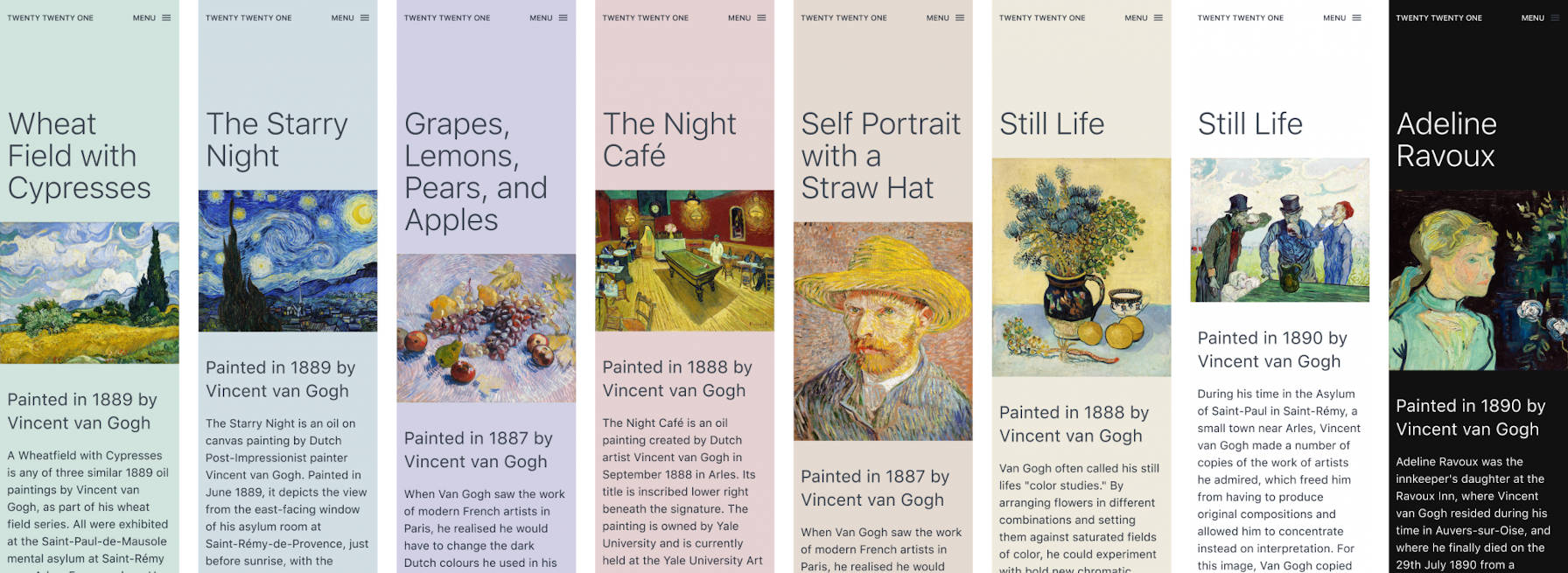Fashion is ephemeral. Art is eternal. Indeed what is a fashion really? A fashion is merely a form of ugliness so absolutely unbearable that we have to alter it every six months!
Thus wrote Oscar Wilde on Victorian-era fashion in an article titled “The Philosophy of Dress” for the New-York Tribune in 1885.
In many ways, WordPress theming is the same as the ever-changing landscape of fashion. Rounded corners are in one day and out the next. Box shadows are in one year after being frowned up just months earlier. Perhaps web design is so intolerable that we must change it every six months. Or, at least freshen it up every year in the case of WordPress.
If art is eternal, there are only two default, Twenty* themes that I can truly recall from past years: Twenty Ten and Twenty Fourteen — yes, Twenty Twenty is memorable, but it is also still the current default. Twenty Ten was a classic that paid homage to WordPress’s past. Twenty Fourteen was such a leap away from tradition that it is hard to forget. Everything else has seemed to fade to varying degrees.
With WordPress 5.6 and the end of the year looming, it is time to look forward to the latest trend. As Mel Choyce-Dwan noted in the announcement of Twenty Twenty-One, the next default theme, “Pastels and muted colors are pretty in right now.”
She is not wrong. The colors are a refreshing change of pace. Now that we are into the second day of autumn, I am getting the good kind of vibes from some of the more earthy-tones from a couple of the color palettes expected to ship with the theme.

Whether Twenty Twenty-One will be a fashionable theme for the year or art that we can remember a decade from now, only history will be able to judge. For now, let’s enjoy the creation and take a look at what we should expect from the next default WordPress theme.
The Current Twenty Twenty-One
The new default theme is a fork of Automattic’s Seedlet, a project in which I lauded as the next step in the evolution of theming. It is a theme that is focused on WordPress’s future of being completely comprised of blocks. It gives us an ideal insight into where theme development is heading. It makes sense as the foundation for the new default. Few other themes would make for a good starting point right now. With WordPress theme development in flux, Seedlet is simply ahead of the pack in terms of foundational elements.

“This provides us with a thorough system of nested CSS variables to make child theming easier, and to help integrate with the global styles functionality that’s under development for full-site editing,” wrote Choyce-Dwan of using Seedlet as a starting point.
There are no plans to spin up a Google Web Font for this theme. The design team is going native and sticking with the default system font stack. Choyce-Dwan listed several reasons for the choice, such as keeping a neutral font that allows broad use, speed, and customizability via a child theme.
Despite the neutral font, the default pastel green is a fairly opinionated design decision. It will not be used broadly across industries. However, the team plans to create multiple color palettes that will give it more range. Presumably, these palettes can also be overwritten.

Other than the colors, the design is relatively simple. Choyce-Dwan said that the theme’s block patterns support is where it will be truly unique.
I was initially unhappy with the patterns that were going to ship with WordPress 5.5. However, an 11th-hour update improved the situation so that they did not feel entirely experimental. The foundational Seedlet theme for Twenty Twenty-One has some unique patterns that begin to scratch the surface of what’s possible with this WordPress feature. My hope is that the new default theme steps it up a notch.
Currently, the theme does not register any custom patterns. However, it has a placeholder file and a note that they are a work in progress. Choyce-Dwan shared some patterns the team has already designed in the announcement.

“We’ll be relying on our talented community designers for more ideas,” she wrote. The team has also created a GitHub template for anyone to contribute pattern design ideas.
Currently, the theme does not support the upcoming full-site editing feature of WordPress. After the Beta 1 release of WordPress 5.6, the team plans to begin exploring the addition of this support. WordPress is expected to ship a public beta of full-site editing in its next major release, but it is unclear whether it will be far enough along to be a headline feature for the Twenty Twenty-One theme.
The team and volunteers have less than a month before the October 20th deadline for committing the new theme to trunk, the core WordPress development branch. At that stage, the theme should be nearly complete and ready for production. Of course, there will be several rounds of patches, bug fixes, and updates before WordPress 5.6 lands in December. Right now is the best time for anyone who wants to get involved with Twenty Twenty-One to do so.
Useful links with more information:
Sadly, the Github gives a wrong information : the theme is not on the depot.